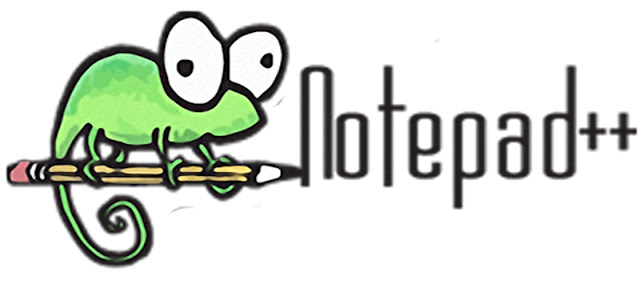1.Notepad ++
Notepad++ is a text editor and source code editor for use with Microsoft Windows. It supports tabbed editing, which allows working with multiple open files in a single window. The project's name comes from the C increment operator.
Notepad++ is distributed as free software. At first the project was hosted on SourceForge.net, from where it has been downloaded over 28 million times,[2][3] and twice won the SourceForge Community Choice Award for Best Developer Tool.[4] The project was hosted on TuxFamily from 2010 to 2015; since 2015 Notepad++ has been hosted on GitHub.[5] Notepad++ uses the Scintilla editor component.
This is the first code editor that I use on windows. Very easy to use, in addition to it also has the very useful plugin to support your programming. Qualifying is lightweight and can still compete with many other code editing tools.
You can download Notepad++ here
2.Visual Studio
Microsoft Visual Studio is an integrated development environment (IDE) from Microsoft. It is used to developcomputer programs for Microsoft Windows, as well as web sites, web apps, web services and mobile apps. Visual Studio uses Microsoft software development platforms such as Windows API, Windows Forms, Windows Presentation Foundation, Windows Store and Microsoft Silverlight. It can produce both native code and managed code.
Visual Studio includes a code editor supporting IntelliSense (the code completion component) as well as code refactoring. The integrated debugger works both as a source-level debugger and a machine-level debugger. Other built-in tools include a code profiler, forms designer for building GUI applications, web designer, class designer, and database schema designer. It accepts plug-ins that enhance the functionality at almost every level—including adding support for source control systems (like Subversion) and adding new toolsets like editors and visual designers for domain-specific languages or toolsets for other aspects of the software development lifecycle (like the Team Foundation Server client: Team Explorer).
Visual Studio supports 36 different programming languages and allows the code editor and debugger to support (to varying degrees) nearly any programming language, provided a language-specific service exists. Built-in languages include C,[6] C++ and C++/CLI (via Visual C++), VB.NET (via Visual Basic .NET), C# (via Visual C#),F# (as of Visual Studio 2010[7]) and TypeScript (as of Visual Studio 2013 Update 2). Support for other languages such as Python,[8] Ruby, Node.js, and M among others is available via language services installed separately. It also supports XML/XSLT, HTML/XHTML, JavaScript and CSS. Java (and J#) were supported in the past.
Microsoft Visual Studio is a premium IDE that costs between $ 699 - $ 2,900 depending on the version and license. Many versions of the IDE have the ability to create all kinds of programs, from web applications to mobile applications to games. This series includes compatibility testing tools so you can see how your applications run on more than 300 devices and browsers. Thanks to its versatility, this tool is a great tool for both students and professionals.
You can download Microsoft Visual Studio here
3.Sublime Text
Sublime Text is a proprietary cross-platform source code editor with a Python application programming interface (API). It natively supports many programming languages and markup languages, and functions can be added by users withplugins, typically community-built and maintained under free-software licenses.
You can download Sublime Text here
4.Vim
Vim ( a contraction of Vi IMproved) is a clone of Bill Joy's vi text editor program for Unix. It was written byBram Moolenaar based on source for a port of the Stevie editor to the Amiga[4] and first released publicly in 1991. Vim is designed for use both from a command-line interface and as a standalone application in a graphical user interface. Vim is free and open source software and is released under a license that includes some charitywareclauses, encouraging users who enjoy the software to consider donating to children in Uganda.[5] The license is compatible with the GNU General Public License through a special clause allowing distribution of modified copies "under the GNU GPL version 2 or any later version".[6]
Although it was originally released for the Amiga, Vim has since been developed to be cross-platform, supportingmany other platforms. In 2006, it was voted the most popular editor amongst Linux Journal readers;[7] in 2015 theStack Overflow developer survey found it to be the third most popular text editor;[8] and in 2016 the Stack Overflow developer survey found it to be the fourth most popular development environment.[9]
You can download Vim here
5.Eclipse
Eclipse is an integrated development environment (IDE) used in computer programming, and is the most widely used Java IDE.[6] It contains a base workspace and an extensible plug-in system for customizing the environment. Eclipse is written mostly in Java and its primary use is for developing Java applications, but it may also be used to develop applications in other programming languages via plug-ins, including Ada, ABAP, C, C++, C#, COBOL, D,Fortran, Haskell, JavaScript, Julia,[7] Lasso, Lua, NATURAL, Perl, PHP, Prolog, Python, R, Ruby (including Ruby on Rails framework), Rust, Scala, Clojure, Groovy, Scheme, and Erlang. It can also be used to develop documents with LaTeX (via a TeXlipse plug-in) and packages for the software Mathematica. Development environments include the Eclipse Java development tools (JDT) for Java and Scala, Eclipse CDT for C/C++, and Eclipse PDT for PHP, among others.



















This comment has been removed by the author.
ReplyDelete